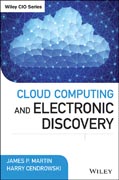
Explore the frontier of electronic discovery in the cloud Cloud Computing and Electronic Discovery comprehensively covers the quickly–evolving realm of eDiscovery in cloud computing environments, a computing and legal frontier in which the rules and legal precedents are being developed anew seemingly by the day. The book delves into this fascinating and rapidly–developing topic to prepare fraud investigators, legal professionals, forensic accountants, and executives understand the ramifications of storing data with third party providers and how such storage mechanisms relate to the limits of discovery practices. This up–to–date resource also includes a complete discussion of the few existing legal precedents and current cases that are shaping interpretation of discovery laws in the cloud space, a perfect overview for executives storing their companies? data in the cloud and the legal professionals tasked with understanding and interpreting the discovery rules surrounding that data. The book is comprehensive in scope and includes: An overview of current trends in cloud computing, including potential information that should be considered in an investigation that involves data held by a cloud service provider Updates on current and proposed laws governing discovery of information held by a third party cloud service provider Updates on legal cases that address the issues of the Electronic Communication Privacy Act, the Federal law prohibiting release of information by a third party provider Practical guidance on how to consider the availability of cloud data relevant to an investigation, and how to include this data in discovery plans For business, accounting, and legal professionals, Cloud Computing and Electronic Discovery is an invaluable resource for understanding the nuanced development of cloud eDiscovery policies, practices, and law as they continue to unfold and develop. INDICE: Preface Acknowledgments Section I Cloud Computing: Basics of Technologies and Applications Chapter 1 Cloud Computing Definitions and Technical Considerations Christopher Thieda IaaS PaaS SaaS Considerations for Discovery Data Transfer Regulations Notes Chapter 2 The Proliferation of Data Available for Discovery James P. Martin and Harry Cendrowski An Example of Third Party Data: Google Search Engine Consideration of Data Points in Discovery Creating an eDiscovery Plan in a Cloud–Based World Production of Cloud Data Notes Chapter 3 Cloud Migration and Planning for Retention James P. Martin and Harry Cendrowski Data Retention and the Cloud Considerations for Litigation Notes Section II Current Laws Affecting Discovery Chapter 4 Brief History of Privacy and Selected Electronic Surveillance Laws James P. Martin and Harry Cendrowski Communications Act of 1934 Title III – Omnibus Crime Control and Safe Streets Act, 1968 Advancements in Telephone System Technologies Electronic Communications Privacy Act of 1986 Notes Chapter 5 Electronic Communications Privacy Act James P. Martin and Harry Cendrowski Title II – the Stored Communication Act §2703 – Required Disclosure of Customer Communication or Records Backup Provisions Electronic Storage and the 9th Circuit Pen Registers and Trap and Trace Devices Production Demands and the ECPA Notes Chapter 6 Proposed Legislative Changes and Future Laws James P. Martin and Harry Cendrowski Points for Improvement Congressional Action Notes Chapter 7 The Control Concept and Related Issues Matthew Breuer and Harry Cendrowski The Application of Rule 34(a) Rule 34(a) in Litigation Flagg – A Modern Day Approach Notes Chapter 8 Current Issues in Cloud Data James P. Martin and Harry Cendrowski Cell Tower Data and Location Information Stingray and Location Monitoring BYOD Policies and Data Ownership Notes Chapter 9 The Rise of Social Media and Its Role in Litigation Sarah Marmour and Dierdre Fox Roots of Social Media Why, How, and When to Access Data on Social Media in Litigation Obligations to Preserve Evidence Accessing Social Media Using Social Media in Litigation Notes Section III Relevant Cases Chapter 10 Cloud Computing and Reasonable Expectations of Privacy: Fourth Amendment Concerns Matthew Breuer and Harry Cendrowski Ex Parte Jackson, 96 U.S. 727 (1877) Olmstead v. United States, 277 U.S. 438 (1928) Katz v. United States, 88 S.Ct. 507 (1967) U.S. v. Miller, 425 U.S. 435 (1976) United States v. Jacobsen, 466 U.S. 109 (1984) U.S. v. Jones, 132 S.Ct. 945 (2012) Summary of Cases Notes Chapter 11 Modern Case Analysis Shaping Litigation Matthew Breuer and Harry Cendrowski O?Grady v. Superior Court, 139 Cal.App.4th 1423 (2006) Krinsky v. Doe 6, 72 Cal.Rptr.3d 231 (2008) Flagg v. City of Detroit, 252 F.R.D. 346 (E.D. Mich 2008) Warshak v. U.S., 631 F.3d 266 (6th Circ. 2010) Ehling v. Monmouth–Ocean Hospital, 872 F.Supp.2d 369 (D.N.J. 2012) Juror Number One v. California, 206 Cal.App. 4th 854 (2012) Notes Chapter 12 Compelled Production of Cloud Computing Data: Fifth Amendment Concerns Matthew Breuer and Harry Cendrowski U.S. v. Doe, 465 U.S. 605 (1984) Doe v. United States, 487 U.S. 201 (1988) United States v. Hubbell, 530 U.S. 27 (2000) In re Boucher, 2009 WL 424718 (D. Vt. 2009) In re Grand Jury Subpoena Duces Tecum Dated March 25, 2011, 670 F.3d 1335 (11th Circ. 2011) Notes About the Contributors About the Authors About the Companion Website Index
- ISBN: 978-1-118-76430-5
- Editorial: John Wiley & Sons
- Encuadernacion: Cartoné
- Páginas: 224
- Fecha Publicación: 24/09/2014
- Nº Volúmenes: 1
- Idioma: Inglés
- Inicio /
- /
